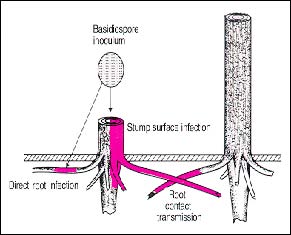
Importance: Annosus root rot (ARR) is a commercially important disease of all conifers. Loblolly and slash pine are most severely affected. It typically enters the tree through a wound, grows through the heartwood into the roots, and causes decay in the root system. Diseased trees are subject to windthrow and breakage.
Identification: The fungus Heterobasidion annosum causes ARR, formerly called Fomes annosus. A fungus growth extending from the trunk of the tree is a “conk.” Conks are positive ARR identification. When fresh, conks are tan to brownish on the upper surface and white with tiny pores on the lower surface. Colors darken once the conk passes through winter. They are rubbery and difficult to tear. Conks are often at the base of dead or dying trees, stumps, or under root masses of windthrown trees. In trees with deep litter, conks may appear on the north side where humidity is higher. In Alabama, most conks develop from December through March. Insects may destroy them before summer or fall.
Not every infected tree will have a conk and in some infected stands, there are none. This is common in stands that have been burned. If no conks are found, growing fungus from suspect trees in the laboratory can identify the disease.
Annosus root rot symptoms can be confused with littleleaf disease. In the absence of conks, remember that littleleaf disease usually occurs on poorly drained clay soils rather than well-drained sandy soils where ARR is commonly found. Bark beetle infestations are often associated with ARR.
After identifying ARR in a few stands, strongly suspect the disease in other stands if there is some combination of the following:

- Pine stands with dead and dying trees often in clusters or rows.
- Trees leaning or blown over from lack of supporting roots.
- Stringy white rot of wood in roots and/or butt.
- Sparse crowns with off-color needles, often with abundant cones.
- Resin-soaked root areas with discolored, dead, or rotted end sections.
- Mortality in second or third year following thinning and continuing for several years.
- Pine stands infested with southern pine beetles or Ips bark beetles.
ARR Soil Hazard Rating: In Alabama, any pine or pine stand may have ARR, although vigorous stands on suitable sites may suffer less damage. A high hazard site is one on which ARR can be reasonably expected to cause mortality and growth loss of a value greater than the cost of prevention. The most consistent indicator of high hazard sites is well-drained, sandy soil to a depth of at least 12". These soils consist of 70% or more sand. Organic soils and soils with indicators of poor internal or external drainage are a low hazard. A high ARR hazard site will always remain so and will always require careful consideration. Every soil type in Alabama has an ARR hazard rating. County foresters can provide this information. A TREASURE Forest plan will also contain this information along with recommended prescriptions.
Prevention: To prevent ARR, maintain healthy stands and recognize high hazard sites. Trees planted out of their natural range on high hazard sites are more susceptible. Longleaf pine is slightly less susceptible on high hazard sites. Planting on wider spacing and thinning should help avoid widespread infection. ARR typically enters the stand when fungal spores land on freshly cut stump surfaces. The fungus grows into nearby live trees via root grafts or contacts. To prevent ARR, treat stumps with borax whenever thinning in a high hazard area.

Control: Once ARR is established and substantial mortality is occurring, control is necessary. Thinning is very risky because root damage promotes infection and the residual stand will be expected to deteriorate rapidly. The stand should probably be clearcut, unless losses can be absorbed until remaining trees reach sawtimber size. The higher sale price may make up for the loss. The site may be regenerated in pine witha small mortality percentage. The problem usually becomes apparent a few years after a thinning cut, often when trees are close to sawtimber size.
If the stand has a localized group of infected trees, salvage the trees including a buffer strip of green trees as wide as the average height of the dominant trees, and treat the stumps with borax. If southern pine beetles or Ips bark beetles are present or are a potential hazard on high ARR hazard sites, their prevention or control must be reconciled with recommendations for ARR.
Thinning On High ARR Hazard Soils: Always cover freshly cut stumps with at least 1/8” of borax within 24 hours of harvest. Borax (Sodium Tetraborate Decahydrate) is sold under several names: Borax, Sporax, Twenty Mule Team Borax, etc. The best method is to sprinkle material “salt-shaker” style. These applicators are available in one or two pound sizes. At proper rates of application, one pound of product will cover 50 square feet of stump surfaces: 260 six-inch stumps, 158 eight-inch stumps, 80 ten-inch stumps, or 60 twelve-inch stumps.
Photo Credit: USFS
Additional Resources